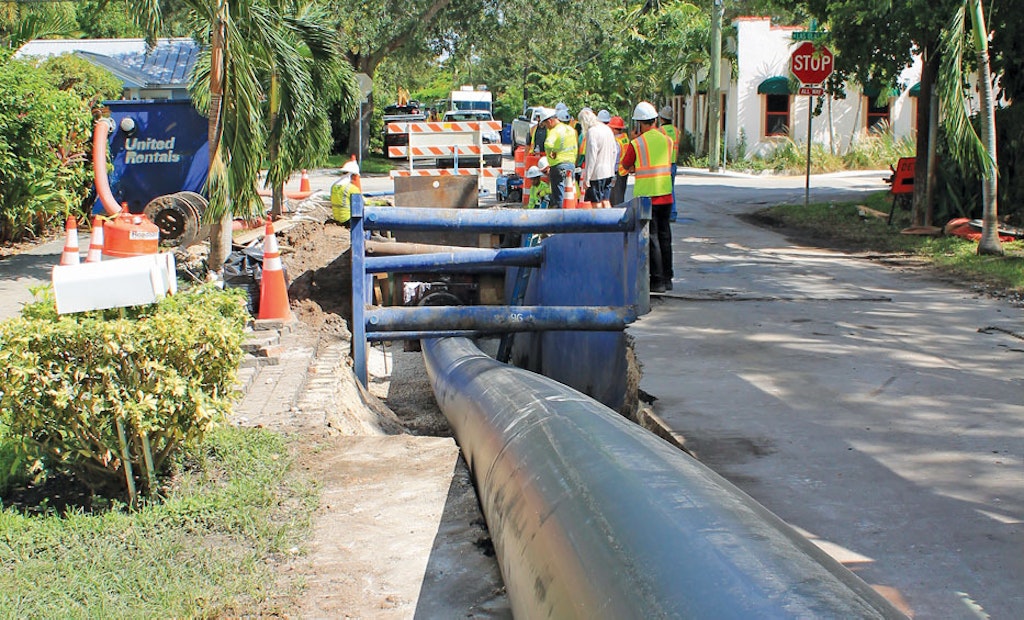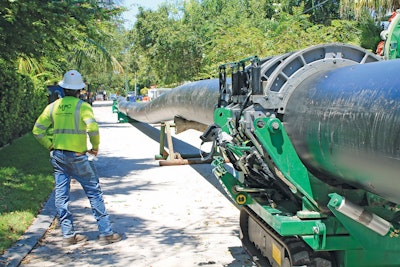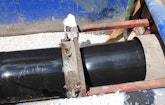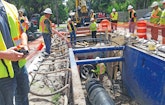
Gravity sewer systems have a reputation for leaks and root growth, especially older infrastructure. With pressure systems, the HDPE pipe is fused, minimizing the potential for leaks and infiltration.
Fort Lauderdale has adopted the motto, “Go Big, Go Fast!” The southeastern Florida city is going big on a $15 million force main project that will improve, upgrade, and enhance its collections system and strengthen infrastructure. And it’s moving fast to complete the emergency project as quickly as possible.
The city didn’t have much of a choice in fixing its failing wastewater system. The issues Fort Lauderdale has endured since December 2016 have been well-documented. Sewer main breaks all over the city have meant sewage spills into the streets, canals and river. The city’s sewer pipes have spewed more than 20.6 million gallons of sewage into local waterways since January 2014.
“It will be nice to make sure that our pipes will be rehabbed and we’re not going to have any more emergencies of this nature,” says Jorge Holguin, city of Fort Lauderdale senior project manager. “It’s a long-term plan for us. We not only rehabilitated the pipes that broke, but even some that have not broken — we’re going to take care of them as well. It’s a pre-emptive manner to try to avoid breaking down in the future. And we also added some redundancy by adding two new interconnections to our existing transmission system.”
Murphy Pipeline Contractors in Pembroke Pines, Florida, was awarded the bid to repair the force main.
“I think some of the community is really happy we’re fixing it because they’re tired of seeing the bursts,” says Richard Crow, regional manager for Murphy Pipeline Contractors. “The patching just wasn’t working — patching that pipe there and have it go break (somewhere else).”
The failing force main became a dire situation for the city, and it was very expensive to continually have overflowing wastewater transported to the plant.
“We can stop conquering sewage around the city, around the areas that are surcharged,” Holguin says. “That’s a huge thing for us. We need to get that done because it’s very expensive. … I would say we’ve spent millions at this point.”
Not all of the city of Fort Lauderdale’s wastewater flows into that particular force main. Holguin estimates it handles about 11 of the city’s average 40 mgd flow.
Murphy Pipeline Contractors was working on the force main project when storms hit Fort Lauderdale in mid-August. The company was asked to help with cleanup for four days before it was able to resume the project.
“The work was somewhat affected by the storm, but we were able to recover,” Crow says.
City goes swagelining
When Murphy Pipeline Contractors presented its plan to the city of Fort Lauderdale representatives, the contractors laid out the advantages of swagelining. So, when the company won the project bid, it was full steam ahead to implement the trenchless technology.
To show that the city was serious about the project, it provided Murphy Pipeline Contractors with a $1 million purchase order to buy the pipe before the contract was even finalized.
“We were contracted with them in about a month; it was a true emergency contract,” Crow says. “We were out there quickly.”
Murphy Pipeline Contractors was in Fort Lauderdale working on Aug. 15. The company has a crew of about 60 employees hammering out the project.
In Phase 1 of the four-phase project, the contractors were swagelining 22,000 linear feet of 30-inch pipe.
“Basically, under tension and through a dye, we shrink a 32-inch HDPE pipe to less than a 30-inch pipe and we slip it through,” Crow says. “Under a revertant process, it reverts back to its original size, giving it a tight, compression-fit liner.”
Murphy Pipeline Contractors has used swagelining quite a bit in past projects with large cities such as Houston and Tampa. It’s gaining traction as an effective method of trenchless rehabilitation around the country.
“We’re gaining ground,” Crow says. “It gives a better fit. It’s kind of like sliplining, but with slip-lining, you’re losing capacity. With swagelining, you basically lose no capacity, just the thickness of the pipe material itself.”
Holguin says, “We thought that would be a very good fit for this particular project. So far, so good. It’s working out pretty well.”
Had Fort Lauderdale opted to dig and replace the pipe, the city would be turned upside down right now with construction everywhere residents look.
“To open-cut a 30-inch pipeline down these neighborhoods and down these businesses and to these streets, it’s a humongous price, but it also has a huge impact on the community itself,” Crow says. “That’s why they went trenchless, and that’s why they went with our technology.”
Ahead of schedule
Using swagelining is going to be very beneficial for the city of Fort Lauderdale, Crow says. One key component: It’s a quick installation. Remember the city’s motto, “Go Big, Go Fast”? This is an important piece to the puzzle.
“The pipe material itself will last about 100 years,” Crow says. “Traditionally, they were using cast iron, but that corrodes — especially when you’re next to the river intercoastal. It’s highly corrosive.”
The first phase of the project, which covers a large section of failing pipe, wrapped up in late fall 2017, well ahead of schedule.
Phase 2 of the project is a 30-inch, 1,500-foot linear direction drill on Las Olas Boulevard right in the downtown area. Phase 3 consists of a 64,000-foot linear directional drill and force main interconnect on Sistrunk Boulevard. When that phase is completed, the fourth phase can commence — roughly 8,400 linear feet of pipe that will be swagelined.
Per the contract, Murphy Pipeline Contractors is scheduled to conclude the project on May 15, 2018. The company is shooting to have the project completed on April 25. Crow is optimistic the entire project will be finished plenty early since the crew will be a couple weeks ahead of schedule after a smooth Phase 1.
There are three active phases going on currently, so the project is progressing quickly.
“A couple weeks ago, we had three drill rigs going at the same time; now, we only have two drill rigs going at the same time,” Crow says. “It’s a 64,000-foot linear drill. It’s a huge drill rig.”
United front
Crow has been very impressed working with Fort Lauderdale officials and their involvement with the project. He says he’s worked with plenty of cities before where city representatives and contractors clash on ideas and perspective, but not on this project.
“A lot of eyes are on it, and they’ve been really supportive,” Crow says. “There hasn’t been a divided front. We’re all talking; this will be project of the year (for the city). This is really huge, and it’s been really successful.”
Crow says the city has attacked the project with urgency and is looking out for the best interests of its residents.
“Do it right, do it safe, and it will last 100 years,” Crow says.








